|
|
|
ASTATIC: An Idea that grew
into an Industry 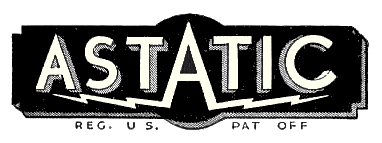
NOTE: This history was
taken from an Astatic brochure from circa 1946.
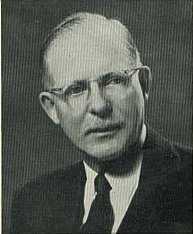
F.H. Woodworth, President |
|
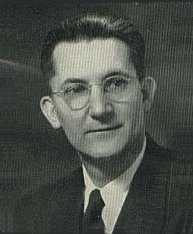
C.M. Chorpening, Vice President |
Away back
in 1930, two radio amateurs, C.M. Chorpening, W8WR radio
(now W8MJM), and F.H. Woodworth, W8AHW, both of Youngstown, Ohio, began
searching for a better microphone for their 'phone transmitters. Up until this
time they had been using various carbon type microphones. The condenser type
appealed to them as an answer to their problem. Several units were designed and given trials
on the air. Before long, other amateurs among their
acquaintances began visiting their shacks, interested in either
building or buying this new type of "mike." Chorpening and Woodworth,
encouraged by this
interest, decided to form a partnership and build these units for their friends.
While this condenser unit proved reasonably satisfactory, it had certain
limitations which it was hoped could eventually be overcome.
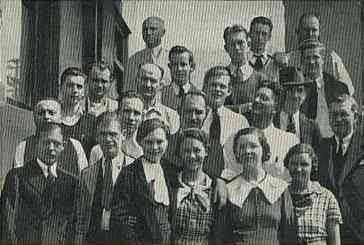
A group of Astatic officials and employees in the early days. |
NEW ELEMENT SUGGESTED
It was about this time that an old acquaintance, Mr.
Charles E. Semple, of Cleveland, who had been visiting his "ham" friends
frequently, invited them to pay him a visit.
With a background of phonograph and loud speaker experience, Mr. Semple
was then occupying bench space in the Brush Laboratories, experimenting with elements made from Rochelle Salts,
(Sodium Potassium Tartrate). Through Mr. Semple, the
two visitors met A.L. Williams, electrical and mechanical engineer, and Dr. C.B.
Sawyer, scientist, who demonstrated to them the action of these new elements in relation
to microphones, phonograph pickups, speakers, recording heads,
earphones, and other devices where it was desired to transform mechanical
energy into electrical energy or the reverse. Here, it seemed, they had found
the answer to a simple, low cost, dependable
"mike" for the ham rig.
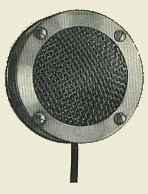
Astatic's first Crystal Microphone, Model D-104. Manufactured in 1933. |
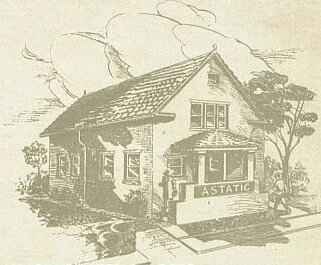
Humble home in which Astatic had its beginning. |
INCORPORATED IN 1933
By 1933, Messrs. Chorpening and Woodworth found it advisable to
incorporate a manufacturing and sales company and to branch out with a line of Crystal
Microphones, Crystal Phonograph Pickups and Recording Heads for manufacturers
and radio jobbers. Mr. Semple was brought into the new organization as designer,
and later served as general manager until his death in 1939.
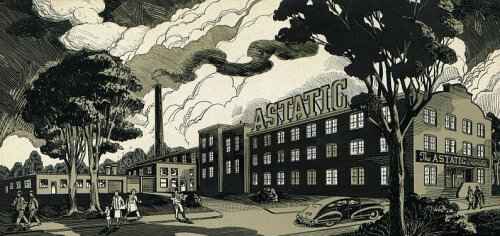
Main Plant and
Offices of The Astatic Corporation at Conneaut, Ohio |
Today, The Astatic Corporation occupies a large, modernly equipped plant on a
three-acre tract of ground in the heart of Conneaut, Ohio, second largest
ore-unloading port on the Great Lakes. The move to Conneaut, from
Youngstown, Ohio, where Astatic was originally incorporated and maintained its
offices and manufacturing plant until late in 1944, was made necessary by the
rapid growth of this important electronics parts industry. Like every new
manufacturing venture, Astatic experienced, but successfully overcame, many
vexing problems to finally find a place of leadership in an industry which today
knows scarcely any limitations. A pioneer in this relatively new field of
science, Astatic has contributed immeasurably to the fidelity of sound pickup
and reproduction as related to radio, electric phonographs and combinations,
with their multiplicity of applications. As the use of electronic devices became
more generally understood and practiced, the demand for Astatic Microphones,
Phonograph Pickups and Cartridges increased and Astatic moved forward in product
design and product facilities.

Left to right: assembling needle chuck to crystal element; servicing
microphone cables; testing phonograph pickups |
The phenomenal growth of The Astatic Corporation is best illustrated by the fact
that twelve hundred employees, as compared to less than a dozen during the first
year of Astatic annals, are now engaged in the manufacture of Astatic's large
line of products. The name "Astatic" has become a symbol for Microphones and
Phonograph Pickups, familiar to everyone interested in electronics. With
representatives in eighteen key American cities, as well as in foreign
countries, the market for Astatic products is world-wide.
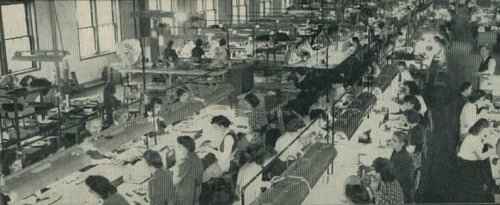
General View
of Main Assembly Floor |
A trip through Astatic's modern Conneaut plant and its amazing complicity of
operations is a revelation in manufacturing achievement. Machines and equipment
of the most modern design are utilized for the making of tools and dies,
machining of parts, in assembly operations, finishing and otherwise contributing
to the manufacture of Astatic products. Visitors to this Astatic plant are
deeply impressed with its modern equipment and facilities, with its fully
equipped laboratory and large engineering department, with its extensive tool
and machine shops, its up-to-the-minute painting and drying department, its
long, busy lines of assembly workers, large office personnel, its clinic, its
cafeteria and other features. And one cannot fail to be impressed, as well, with
the constant supervision over all these operations, designed to insure, through
careful manufacture and constant testing, the ultimate performance of Astatic
products in the field.
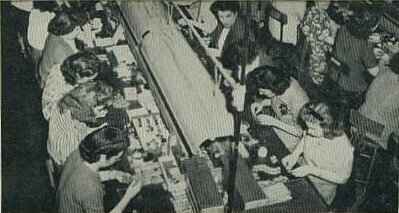
Assembling Pickup Cartridges |
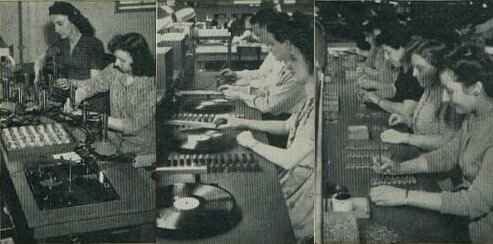
Left to right:
Testing Astatic microphones, testing crystal cartridges, cementing
damping pads in cartridge housings |
Astatic engineering personnel,
quarters and equipment have been extensively increased at the new Conneaut plant
to facilitate research and development work. This new department now includes a
modernly equipped laboratory with the most approved types of measuring and
testing equipment, and is co-ordinated with the
mechanical engineering and drafting units.
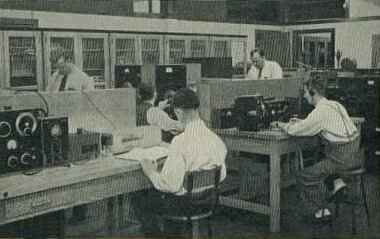
Partial view of Astatic Engineering Laboratory |
FIELD OF APPLICATIONS FOR ASTATIC PRODUCTS IS CONSTANTLY INCREASING
With science delving ever deeper into the possibilities of electronics, the
broadening field of applications for Astatic pickups and sound reproducing
devices knows scarcely any limitations. Long familiar to almost everyone
associated with radio and phonograph manufacturing and amateur activities,
Astatic Microphones, Phonograph Pickups, Cartridges and Recording Heads are now
destined to find modern uses in hundreds of new applications. Astatic engineers
and laboratory technicians are in a position to offer assistance to Astatic
customers in the possible adaptation of Astatic products to special
applications.
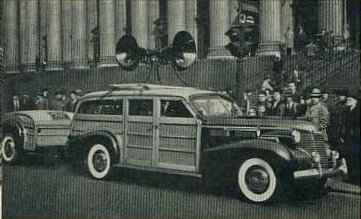
Mobile Sound
System equipped with two Astatic K-2 Microphones |
Astatic Crystal and Dynamic Microphones are designed in many models for general
use, as well as special applications. Among these are: radio broadcast stations;
amateur radio stations; public and mobile address systems; airway
communications; police radio networks; inter-office, plant, and field
communications systems; educational institutions; home recording combinations;
office dictating machines; criminal detection devices and many others. Their use
now, naturally, will include two-way communications systems for railroads,
ships, bus lines, taxicab networks. In addition, Astatic Microphones have many
and varied industrial applications; to test machinery for vibrations and noises;
watch timing; water-leak detection and location; and other special demands.
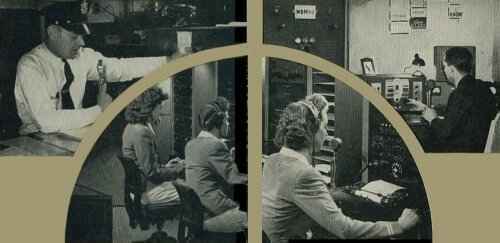
(upper left) Police Network Installation employing Astatic
Microphones.
(center left) Astatic Microphones used in Airline Dispatch.
(center right) Office Installation with Wilcox Elec. Co. equipment.
(upper right) Astatic Microphones extensively used with amateur rigs. |
Astatic Phonograph Pickups and
Cartridges are used by a majority of the leading manufacturers of electric
phonographs, radio-phonograph combinations, coin operated phonographs, home
recording combinations, and other similar types of equipment. Most phonograph
pickup arm designs used by important set manufacturers are based upon Astatic
Cartridge dimensions, thus making Astatic Cartridges suitable for practically
all replacement requirements.

Two versions of Astatic Pickup Arms as used on portable phonographs. |
In addition to supplying
manufacturers of original equipment, Astatic products are distributed by parts
jobbers here and abroad for repair, replacement and improvement of existing
equipment.
Phonograph Pickup Cartridges, of
which Astatic is perhaps the world's largest producer, are made in many models
to meet today's varied requirements and exacting demands. It is natural,
therefore, that Astatic Cartridges are the choice of most engineers designing
phonograph equipment, whether it is for simple, manually operated players or the
most elaborate automatic changer combinations.
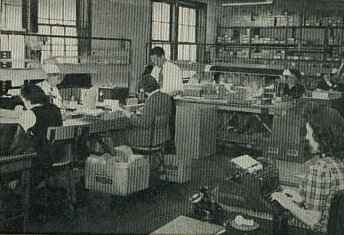
Manufacturer
and Jobber Service Department |
For the accommodation of its many
Radio Parts Jobber and Manufacturer customers, Astatic has long maintained a
special service department. Products failing to meet Astatic's high standards of
operating efficiency, as the possible result of defects in material or
workmanship, are here repaired or replaced according to their needs. This
cooperation insures customer satisfaction and confidence.
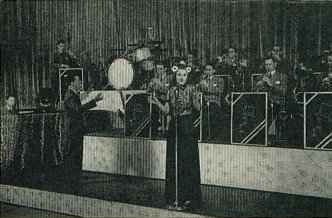
Astatic Microphones popular for public address and sound system
applications. Tommy Tucker's Orchestra shown above using Astatic
microphones. |
ASTATIC'S CONTRIBUTION TO THE WAR
EFFORT (WORLD WAR II)
For its liberal contribution to the
war effort, The Astatic Corporation received, along with many congratulatory
letters for meritorious accomplishments, the U.S. Navy Certificate of
Achievement.
In addition to great quantities of
Microphones, Pickups and Crystal Cartridges supplied to the Armed Forces and
essential industries during the war period, Astatic designed, perfected and
manufactured many other types of electronic equipment. Included were a number of
under-water sound detection or Sonar devices. Astatic, as a result, became one
of the largest producers of Hydrophones for the U.S. Navy under direct contract,
and for other manufacturers of Sonar equipment on a subcontract basis.
For Army and Navy Bomber and
Fighter Planes, Astatic perfected and produced, in large quantity, a Static
Discharger, for dissipating static electricity which accumulated, due to
friction in flight, on wing surfaces, fuselage and tail assemblies.
A further contribution was made by
Astatic in the design and manufacture of Co-Axial Cable Connectors used
exclusively by both the Army and Navy for Radio, Radar and Sonar hookups and
installations. As a result, The Astatic Corporation became the country's largest
producer of these items, shipping in one month, during peak production, a total
of over 650,000 units. |


















